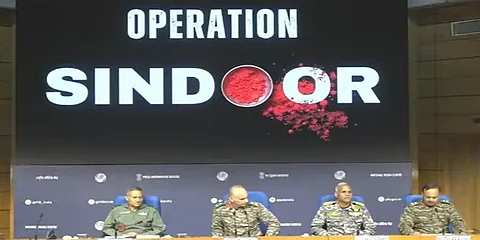

After India and Pakistan agreed to a ceasefire, a press conference was held on Operation Sindoor. Lieutenant General Rajiv Ghai, Vice Admiral AN Pramod, and Air Marshal Avdhesh Kumar Bharti addressed the media about Operation Sindoor. In the morning, a meeting was held in the Prime Minister's Office (PMO) between the Defense Minister, the three military chiefs, the Chief of Defense Staff (CDS) and the National Security Advisor (NSA). Due to this, the Defense Ministry's press briefing scheduled for 11 am was postponed.
India and Pakistan agreed on a ceasefire on May 10 at 5 pm. Both countries decided that to further improve the situation, talks will be held at the DGMO i.e., Director General of Military Operations,level on May 12.
Addressing the media, Lieutenant General Rajiv Ghai said, "You are all by now familiar with the brutality and the dastardly manner in which 26 innocent lives were prematurely terminated at Pahalgam on 22nd April. When you combine those horrific scenes and the pain of the families that the nation witnessed with numerous other recent terrorist strikes on our armed forces and defenceless civilians, we knew that the time had arrived to make yet another compelling statement of our resolve as a nation. Operation Sindoor was conceptualized with a clear military aim to punish the perpetrators and planners of terror and to destroy their terror infrastructure. What I do not state here is the often stated determination of India and its intolerance to terror."
"..In those strikes across 9 terror hubs left more than 100 terrorists killed...It set into motion a very diligent and microscopic scarring of the terror landscape across the borders and the identification of terror camps and training sites. The locations that emerged were numerous, but as we deliberated more, we realised that some of these terror hubs were now bereft of presence and had preemptively been vacated, fearing retribution from us...There was also a term of reference and our own binding self imposed restriction to target only terrorists and thus prevent collateral damage. There were nine camps that you are now all familiar with which were confirmed by our various intelligence agencies to be inhabited.
Some of these were in PoJK, while there were others that were located in the Punjab Province in Pakistan. Nefarious places such as Muridke, the hub center of the Lashkar-e-Taiba has over the years bred infamous characters such as Ajmal Kasab and the likes of David Headley."
Lieutenant General Rajiv Ghai further said "...Those strikes across those nine terror hubs left more than 100 terrorists killed, including high value targets such as Yusuf Azhar, Abdul Malik Rauf and Mudasir Ahmed that were involved in the hijack of IC814 and the Pulwama blast. The line of control was also violated soon after by Pakistan and the erratic and rattled response of our enemy was apparent from the number of civilians, inhabited villages and religious sites such as Gurudwaras that were unfortunately hit by them, leading to a sad loss of lives. The Indian Air Force played a major part in these strikes by engaging some of these camps and the Indian Navy provided wherewithal in terms of precision munitions. The Indian Air Force had their assets up in the sky..."
After Lt. Ghai, Air Marshal AK Bharti showcased the detailed missile impact video and photos of various terror infrastructures that were destroyed in Pakistan. See below-
Before
After
Before: Terror Camp 2